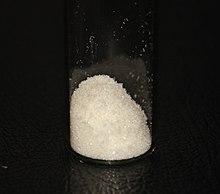Loading AI tools
Heterocyclic organic compound From Wikipedia, the free encyclopedia
1,10-Phenanthroline (phen) is a heterocyclic organic compound. It is a white solid that is soluble in organic solvents. The 1,10 refer to the location of the nitrogen atoms that replace CH's in the hydrocarbon called phenanthrene.
 | |
 | |
| Names | |
|---|---|
| Preferred IUPAC name
1,10-Phenanthroline[1] | |
| Identifiers | |
3D model (JSmol) |
|
| 126461 | |
| ChEBI | |
| ChEMBL |
|
| ChemSpider | |
| DrugBank | |
| ECHA InfoCard | 100.000.572 |
| EC Number |
|
| 4040 | |
| KEGG | |
PubChem CID |
|
| RTECS number |
|
| UNII |
|
| UN number | 2811 |
CompTox Dashboard (EPA) |
|
| |
| |
| Properties | |
| C12H8N2 | |
| Molar mass | 180.21 g/mol |
| Appearance | colourless crystals |
| Density | 1.31 g/cm3 |
| Melting point | 118.56 °C (245.41 °F; 391.71 K)[2] |
| Boiling point | 409.2[2] |
| high[2] | |
| Solubility in other solvents | acetone, ethanol[2] |
| Acidity (pKa) | 4.84 (phenH+)[2] |
| Hazards | |
| Occupational safety and health (OHS/OSH): | |
Main hazards |
mild neurotoxin, strong nephrotoxin, and powerful diuretic |
| GHS labelling: | |
  | |
| Danger | |
| H301, H410 | |
| P264, P270, P273, P301+P310, P321, P330, P391, P405, P501 | |
| Related compounds | |
Related compounds |
2,2'-bipyridine ferroin phenanthrene |
Except where otherwise noted, data are given for materials in their standard state (at 25 °C [77 °F], 100 kPa).
| |
Abbreviated "phen", it is used as a ligand in coordination chemistry, forming strong complexes with most metal ions.[3][4] It is often sold as the monohydrate.
Phenanthroline may be prepared by two successive Skraup reactions of glycerol with o-phenylenediamine, catalyzed by sulfuric acid, and an oxidizing agent, traditionally aqueous arsenic acid or nitrobenzene.[5] Dehydration of glycerol gives acrolein which condenses with the amine followed by a cyclization.
In terms of its coordination properties, phenanthroline is similar to 2,2'-bipyridine (bipy) with the advantage that the two nitrogen donors are preorganized for chelation. Phenanthroline is a stronger base than bipy. According to one ligand ranking scale, phen is a weaker donor than bipy.[6]
Several homoleptic complexes are known of the type [M(phen)3]2+. Particularly well studied is [Fe(phen)3]2+, called "ferroin." It can be used for the photometric determination of Fe(II).[7] It is used as a redox indicator with standard potential +1.06 V. The reduced ferrous form has a deep red colour and the oxidised form is light-blue.[8] The pink complex [Ni(phen)3]2+ has been resolved into its Δ and Λ isomers.[9] The complex [Ru(phen)3]2+ is bioactive.[10]
1,10-Phenanthroline is an inhibitor of metallopeptidases, with one of the first observed instances reported in carboxypeptidase A.[13] Inhibition of the enzyme occurs by removal and chelation of the metal ion required for catalytic activity, leaving an inactive apoenzyme. 1,10-Phenanthroline targets mainly zinc metallopeptidases, with a much lower affinity for calcium.[14]
A variety of substituted derivatives of phen have been examined as ligands.[12][15] Substituents at the 2,9 positions confer protection for the attached metal, inhibiting the binding of multiple equivalents of the phenanthroline. Such bulky ligands also favor trigonal or tetrahedral coordination at the metal.[16] Phen itself form complexes of the type [M(phen)3]Cl2 when treated with metal dihalides (M = Fe, Co, Ni). By contrast, neocuproine and bathocuproine form 1:1 complexes such as [Ni(neocuproine)Cl2]2.[17]
| phen derivative | pKa | comment/alt. name | numbering scheme |
|---|---|---|---|
| 1,10-phenanthroline | 4.86 | phen |  |
| 2,2'-bipyridine | 4.30 | bipy | |
| 5-nitro-1,10-phenanthroline | 3.57 | ||
| 2,9-dimethyl-1,10-phenanthroline | unknown | neocuproine[19][20] | |
| 2,9-Dimethyl-4,7-diphenylphenanthroline | unknown | Bathocuproine[19][21] | |
| 4,7-dimethyl-1,10-phenanthroline | 5.97 | ||
| 4,7-diphenyl-1,10-phenanthroline | unknown | bathophenanthroline[22] | |
| 5,6-dimethyl-1,10-phenanthroline | 5.20 | 5,6-Me2phen | |
| 3,4,7,8-tetramethylphenanthroline | 6.31 | 3,4,7,8-Me4phen[23] | |
| 4,7-dimethoxy-1,10-phenanthroline | 6.45 | 4,7-(MeO)2phen[24] | |
| 2,6-dimesitylphenanthroline | unknown | HETPHEN[25][16] |
Alkyllithium reagents form deeply colored derivatives with phenanthroline. The alkyllithium content of solutions can be determined by treatment of such reagents with small amounts of phenanthroline (ca. 1 mg) followed by titration with alcohols to a colourless endpoint.[26] Grignard reagents may be similarly titrated.[27]
Seamless Wikipedia browsing. On steroids.
Every time you click a link to Wikipedia, Wiktionary or Wikiquote in your browser's search results, it will show the modern Wikiwand interface.
Wikiwand extension is a five stars, simple, with minimum permission required to keep your browsing private, safe and transparent.